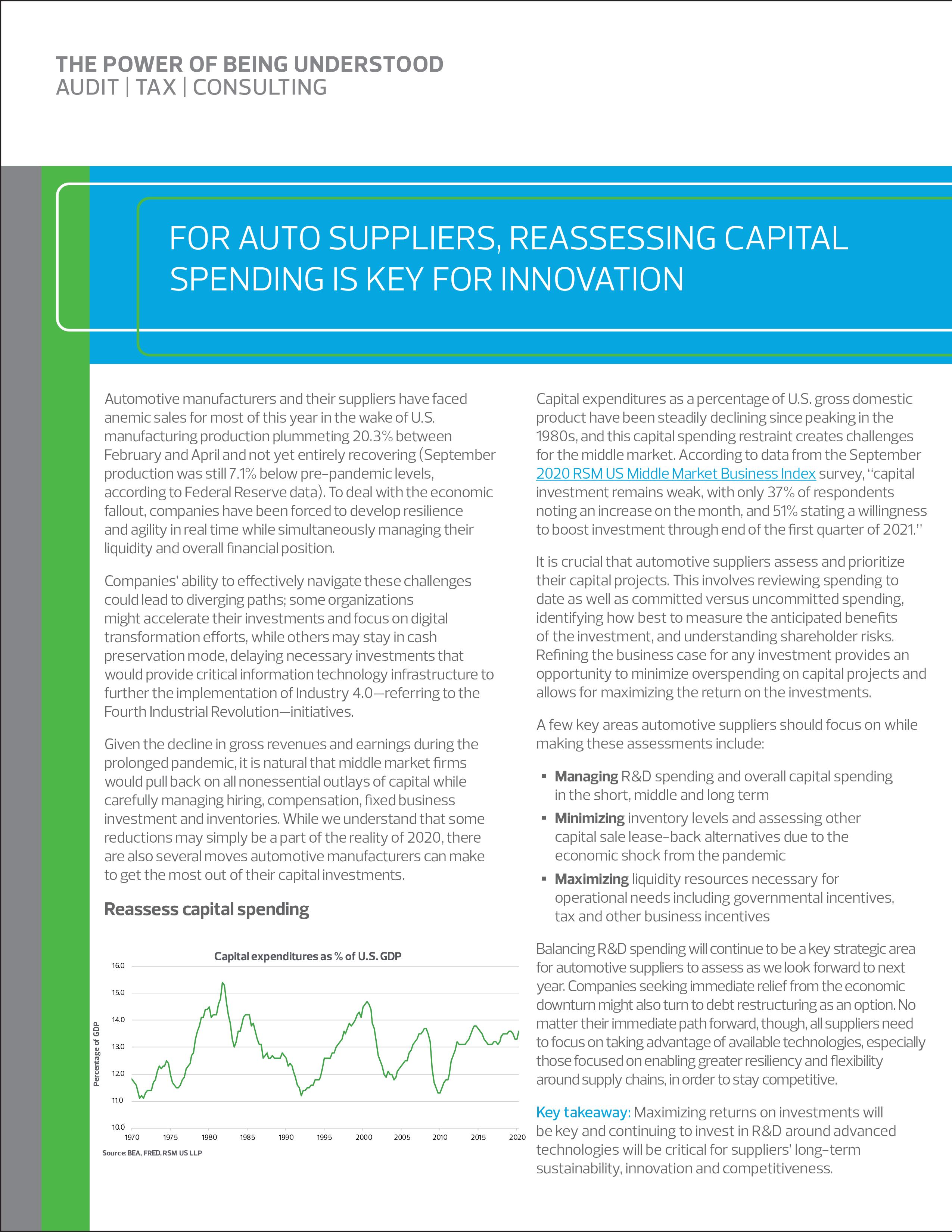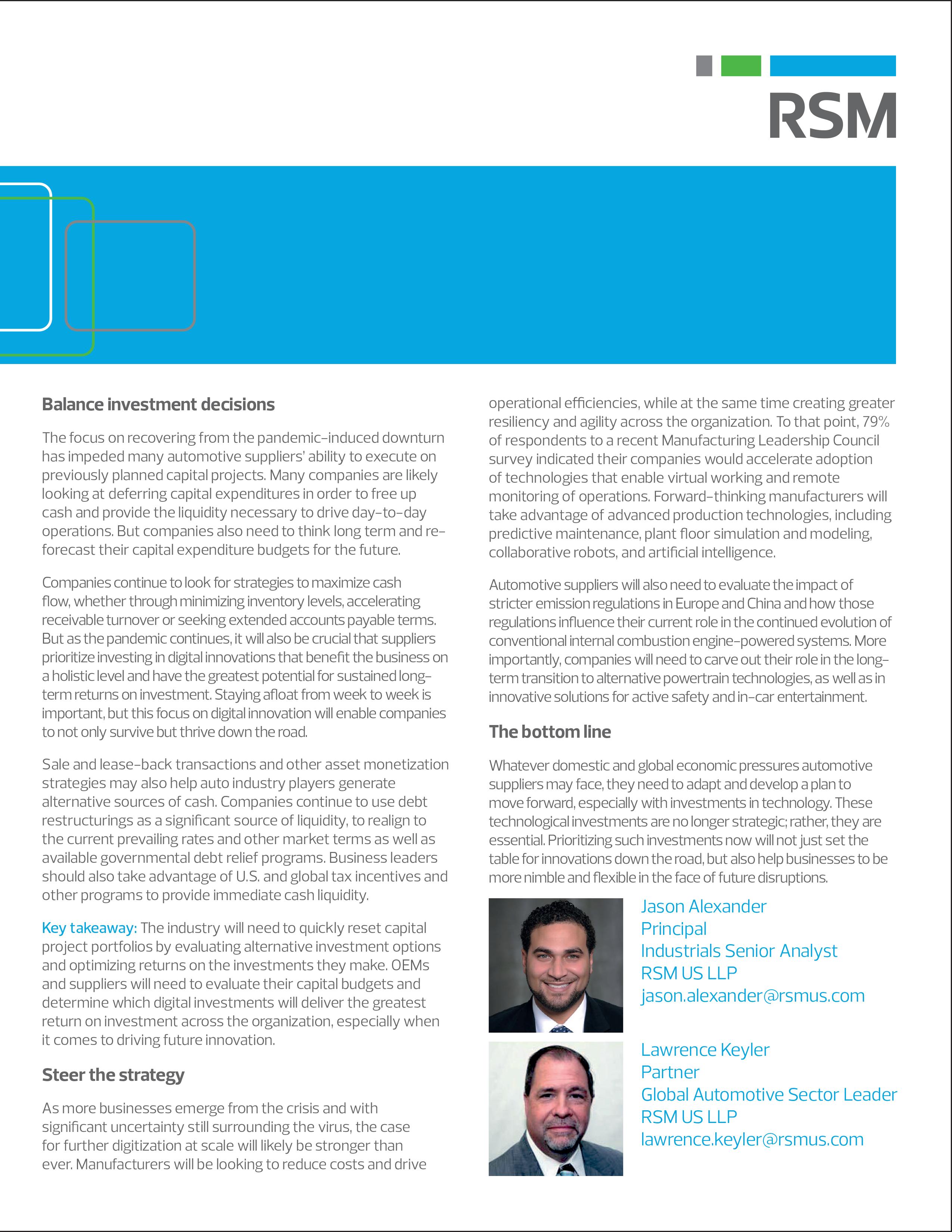
6 minute read
RSM Supplier Barometer Commentary

Leverage disruptions to unlock supply chain and Leverage disruptions to unlock supply chain and organizational resilience organizational resilience Authored by: Jeff Jorge Contributor: Erich Bergen
Advertisement
Principal, Baker Tilly Director, Baker Tilly International Growth Services Practice Leader +1 (248) 368 8741 +1 (248) 368 8789 erich.bergen@bakertilly.com jeff.jorge@bakertilly.com
The pandemic has exposed the strengths and weaknesses of nearly every organization in nearly every industry, but what has been most telling is how organizations have responded to this crisis. There are those that have had to succumb to the financial impact, while others — even in the same sector — have been able to stay afloat. Jeff Jorge, Baker Tilly principal and international services practice leader, presented “Black Swan confined: Leveraging macro-level turmoil to unlock supply chain and organizational resilience” at the 2020 OESA Automotive Supplier Conference. He discussed what organizations can do to turn significant external pressures into a competitive advantage as well as how they can plan for future “black swan” events.

Guideposts
Leaders who believe the concept that challenges bring opportunities for innovation and growth seem to oversee the organizations that have best weathered this crisis. For organizations that are still struggling to see the potential, Jorge said he recommends looking at the following guideposts. They range from factors we cannot control (guideposts one and two) to elements that are more controllable (guideposts three, four and five):
1.
2.
3.
Geopolitical and social economic risk: This is everything that we see, not only the global pandemic but every dynamic and interplay among the large economies (e.g., U.S., China, the European trade bloc and countries within it, Latin America, etc.) as well as the sectors and governments that permit this interplay of economic prosperity to occur. Disruption-based competitive pressures: The pandemic forced organizations to make significant changes quickly, and many came to the unhappy realization that their competitors were better prepared than they were. For the most part, organizations have little insight into the innerworkings of their competitors. That unknown creates a different kind of external stress. Rapid foresight processing and planning: This is the first (and crucial) step in how an organization can become less reactive and more anticipatory. Leverage data analytics and planning foresight to understand the current reality head-on, to make decisions that preserve the value the organization has created to this point — and to enhance the value it generates in the future.
4.
5.
Supply chain DNA manipulation: Successful leadership embraces radical change when it is necessary. As it relates to supply chain, this translates into leveraging internal and external information to take a clear-sighted perspective of what you have been doing and look at making changes that you may have never thought possible or would have ever considered before. Sustainability: No matter what changes an organization has to make to both survive during and thrive following a catastrophic event, leadership has to ensure the actions it has put in motion are not a short-term fix. That the decisions made today require a longer-term view and, simultaneously, inject operational and cultural resilience that enables the organization to survive the next major disruption — not just to get through this one.
It is up to leadership to determine how to harness and implement these guideposts appropriately within their organization.
Use guideposts to maximize resiliency
To use these guideposts in a way that is actually meaningful and actionable, Jorge suggested “evaluate the output of guideposts three, four and five in order to create a platform for growth that is sustainable and avoids risks that could put you in a position to behave differently from peers in your sector.” Even though your organization cannot control the first two stages, be mindful of them, Jorge said. In fact, use what information you can glean from those external factors to shape what you do in the foresight processing and planning stage. He suggests borrowing a page from organizations that lead their field in supply chain responsiveness and resilience by following the key sequential actions they take, including: 1. Integrate supply chain strategy and enterprise strategy 2. Leverage analytics and visual/dynamic scenario planning to evaluate the economic and strategic benefits from possible supply chain changes 3. Decisively implement alternate business models or supply chain (re)designs that increase velocity in information processing, planning and action
Integrated data gives organizations the ability to plan properly, respond thoughtfully and transform how they not only react to changes to their supply chain, but also drive profitable growth. Once an organization is employing data analytics to be more proactive, it can use that information to change the “DNA” of its supply chain with confident and assertive measures. Before March 2020, it would have been unthinkable for a well-oiled supply chain organization to change what it has been doing for years. The pandemic has made it necessary, even imperative, for organizations to reconsider and rework the operational excellence that has been woven into the DNA of its supply chain and then implement the technological updates required to survive the next disruption that may be around the corner. Finally, to transition from post-shock stability into sustainability, an organization should focus on and drive growth-enabled actions, which inevitably leads to ongoing near real-time supplier risk monitoring and management. With the combined approach shared here, manufacturers can glean visibility into layers far beyond the first tier of suppliers and risks therein, resulting in an aggregated dashboard-style view of the health of its supply chain. Build this into the rhythm of an organization in running the business and leading its people, and one can begin to see how the journey from reactive to anticipatory is both achievable and, with proper commitment and support, sustainable.
Leadership’s role
Executing strategic and business alternatives with discipline and rigor relies heavily upon sound leadership. As Jorge said in his session, “the three controllable guideposts — those that help transition an organization from a position of ‘pandemic victim’ to an empowered one — are unlikely to happen without people working together to conquer obstacles that individually may seem insurmountable, yet are highly achievable collectively.” For successful execution, Jorge encourages leaders to consider the following: 1. Harness uncertainty: Consider how the impact of uncertainty can be leveraged to supercharge team unity and performance and to unlock additional organizational strength. You are likely to be surprised with what your team can achieve. 2. Plan and prioritize: Use analytics, visual insights and dynamic strategic planning to clarify organizational priorities and unearth the untapped capabilities mentioned previously. 3. Assess organizational culture: Reflect on whether your organization’s culture allows for creative engagement during times of crisis or ambiguity as well as for psychological safety where team members can offer ideas, be vulnerable and develop solutions without feeling they are at risk by voicing their perspective. Leverage the current environment, one where our professional lives collide with our personal/ home life, to supercharge the establishment of a culture of
“whole self-inclusion” and the performance excellence that inevitably follows. 4. Lead intentionally. Be visible, communicative and empathetic.
Recognize one’s role as a leader and the responsibility to crystalize the vision of a future that has not yet happened. A future that actually begins today and that you — the leader — will guide the team to. Show them that your organization’s tomorrow is going to be better than its today and, while you may not have all the answers, collectively, you will chart the path and shape such a better future — starting now.
For additional details, insights, and exclusive toolkits to leverage within your organization and experience the results above, visit bakertilly.com or contact Jeff Jorge.
About Baker Tilly
More than 4,200 professionals strong, Baker Tilly is a leading advisory, tax and assurance firm with experienced mobility and transportation professionals that provide growth, operations and business technology services to help all members of the mobility and transportation supply chain improve decision making and operational efficiencies. Headquartered in Chicago, Baker Tilly, and its affiliated entities, have operations in North America, South America, Europe, Asia and Australia. Baker Tilly is an independent member of Baker Tilly International, a worldwide network of independent accounting and business advisory firms in 146 territories, with 36,000 professionals.




